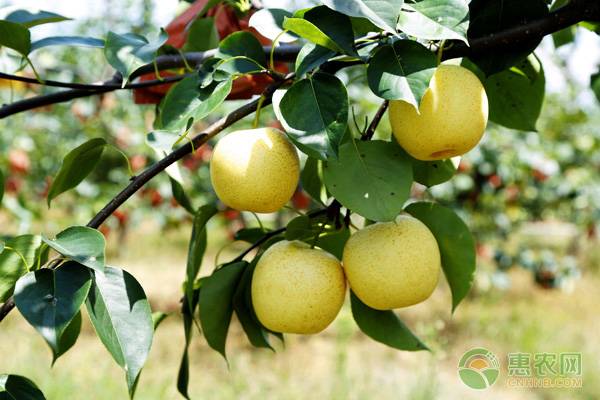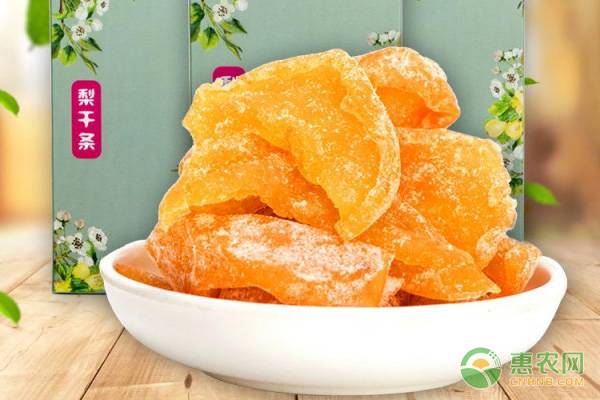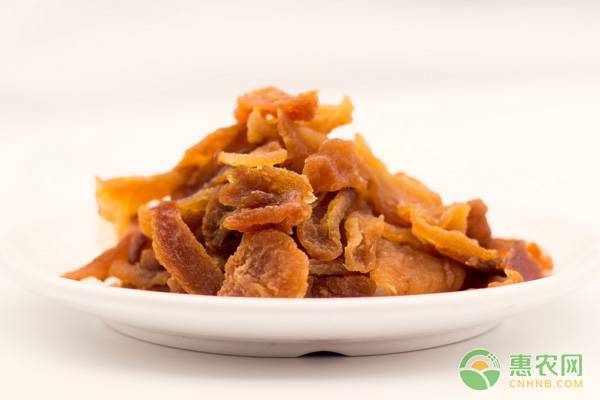Processing methods and quality requirements of five common pear products
Pear has a long history of cultivation in China. At present, the total output of pears accounts for about 20% of the national fruit production, which is the most fruit production in China. Pears are more concentrated, most pears are not resistant to storage, and the price is low. If they are properly processed, they can be supplied to the market on an annual basis. The following small series introduces the processing methods of five common pear products. First, sugar pear 1, the process Raw material selection → cleaning → peeling the fruit handle → cutting to the heart → dressing → color protection → top cooking → sorting → canning → heating and exhausting → sealing the tank → sterilization, cooling → wiping the can, into the warehouse. 2, operating points (1) Raw materials. Should choose fresh and full, maturity of 70 to 80%, fine meat, less stone cells, normal flavor, no mold, frostbite, pests and diseases and mechanical damage. Horizontal diameter standard: Laiyang pear and snow pear 65 mm ~ 90 mm, pear and long pears 60 mm or more, white pear 55 mm or more, individual varieties can be below 50 mm. (1) Cleaning. Wash the epidermis with water and soak for 5 minutes in 0.1% hydrochloric acid solution to remove surface wax and pesticide, then wash with water. (2) Peel the fruit handle. Remove the fruit handle first, then peel it mechanically or by hand. (3) Cut to the heart. Use a stainless steel fruit knife to cut into two halves and remove the heart and flower buds. (4) Trimming and color protection. Remove mechanical, insect spots, residual peel, etc., then put in 1% ~ 2% saline to soak the color, and then wash twice with water. (5) Pre-cooked. 0.1% to 0.2% of citric acid is added to the clean water, and the mixture is heated and boiled. Look at the size of the fruit to cook for 5 minutes to 10 minutes, to cook thoroughly but not bad. (6) Sorting. According to the size, color and maturity of the fruit, the soft, rotten and discolored fruit pieces are removed. (7) Canning. In the sterilized glass jar, 290 g of fruit pieces were placed, and 220 g of sugar water was added. (8) Heating the exhaust. After the canning, the exhaust box is sent to heat the exhaust gas, and the center temperature of the tank is above 80 °C. (9) Sealing the can. Put the can lid on the can and seal the can on the can sealing machine. (10) Sterilization and cooling. The cans were boiled in boiling water for 15-20 minutes and then cooled to 38 °C in sections. (11) Wipe the cans and put them into storage. Dry the water and store it in a room temperature room for one week. 3. Quality requirements The flesh is white or yellow with a consistent color. The sugar water is more transparent. A small amount of pulp debris that does not cause turbidity is allowed. The canned pears of this variety should have a flavor, sweet and sour taste, no odor. The pear slices are soft and hard, and there is no rough stone cell sensation when eating. The block is complete. The size of the fruit pieces in the same can is the same. No mechanical injuries and insect spots. The flesh is not less than 55% of the total net weight. The concentration of syrup is not less than 14%-18% (according to the refractive index when opening the can). 4, matters needing attention For varieties with an acidity of less than 0.1%, citric acid with a depth of 0.15% to 0.2% should be added to the sugar water. The production process must be rapid, especially in the handling of fruit, canning and sterilization. When pre-cooking, it should be watery, steamy, and suitable in quantity. Do not use pears with low maturity or storage, and soak them in boiled pear water at 30 °C for 30 minutes in winter to prevent discoloration of pears during pre-cooking. Second, pear candied fruit 1, the process Raw material selection → peeling → soaking lime water → rinsing → sugar stains, sugar boiling → cooling → packaging. 2, operating points (1) Raw materials. It can be used as a raw material without mechanical damage, no rot, and suitable for processing pear and pear, such as various sour pears and pears. (2) Peeling. Pick qualified pears and rinse them with water to remove the skin. (3) Soak lime water. Put the peeled pear in 15% to 20% of fresh lime water, mainly to submerge the pear, soak for 3 days to 5 days, and turn it twice a day. (4) Rinsing. Put the pear blank into the water tank for 4 days to 5 days, change the water twice a day, rinse off the lime water, remove it, and drain the water. (5) Candied sugar, candied. Pour the pear slab together with the sugar liquid into the aluminum pan, heat and boil, add the granulated sugar which is 30% of the pear slab weight, cook for about 1 hour with the fire, and then pour the sugar liquid into the pot and pour the sugar for 1 day. The next day, pour the boiled pear liquid into the pot and boil it. Add 30% sugar to boil for about 1 hour, cook until the temperature reaches 108 °C ~ 110 °C, use a shovel to shovel the sugar liquid, when the sugar liquid can flow down. Starting with sugar, it means that the sugar is cooked. (6) Cooling. Quickly use a large colander to remove the pear pieces and move them to the plate to cool them immediately to get the finished product. (7) Packaging. Packed in a 0.5 kg plastic film food bag and sealed for shipment. 3. Quality requirements The surface is dry, the inside is moist, the taste is sweet and crisp, and the sugar content is about 65%. Third, pear 1, the process Raw material selection→peeling→rinsing→cutting half-nuclear→smoke and sulfur→sweet stains→first sugar cooking→sugar stains→second sugar cooking→sugar stains→shaping→baking→packaging. 2, operating points (1) Raw materials. The fruit size is relatively consistent, and the maturity is about 60% to 80%. The meat is thick, the moisture content is low, and there are no insects and bruises. (2) Peeling. Formulate about 3% sodium hydroxide solution, heat and boil, then pour the pear into the pot and boil for about 15 minutes. The thin time of the pear skin can be shorter, then pick up the bamboo pole. (3) Rinsing. Rinse the pears with bamboo stalks in water and rinse the peels. (4) Cut the half to go nuclear. Cut the pear in half with a fruit knife and dig the core of the fruit. (5) Sulphur. Pear fruit is immersed in a sulfuric acid solution containing 0.1% to 0.2% sulfur dioxide for 4 to 8 hours (the solution concentration is high, the time can be shorter). Then rinse with water and drain. (6) Candied fruit. Weigh the sugar that accounts for 20% of the weight of the pear. Stir well and immerse for 1 day. (7) The first time of cooking. On the second day, weighed 20% of the weight of the pear pieces into a copper pot, added water equal to the amount of sugar, heated and melted, and poured the sugar and pear into the copper pot for about 20 minutes. (8) Candied fruit. Pour the pear pieces together with the sugar solution and continue the syrup for 1 day. (9) The second time of cooking. On the third day, 20% of the sugar was weighed in the second time according to the above method, and the time was about 30 minutes. (10) Sugar stains. Continue to stain for 1 day, so that the sugar solution can penetrate into all parts of the pear. (11) Plastic surgery. Squeeze the syruped pear pieces and place them on the baking tray, taking care not to stack too thick. (12) Baking. The baking tray containing the pears is sent to the drying room, and baked at a temperature of 50 ° C to 60 ° C (the temperature can not be too high, so as to avoid the coking of the sugar agglomerates), and the finished pears can be obtained in one day or one and a half days. (13) Packaging. It is usually packaged in a plastic film food bag and then placed in a cardboard box. 3. Quality requirements The high-quality pear has a flat shape, golden color, even sugar distribution, and the surface of the crucible is not sticky, sweet and slightly acidic, and has no burnt smell. Four pears 1, the process Raw material selection → peeling → cutting → immersion brine → fuming sulfur → dry → packaging. 2, operating points (1) Raw materials. Choose meat with soft and delicate meat, less stone cells, high sugar content, strong aroma and small heart, such as barley, rosewood, eggplant pear, etc., remove rotten fruit and overripe fruit. (2) Peeling. The outer skin of the pear is rough and must be peeled. The fruit stems and sepals can be removed manually and mechanically. (3) Segmentation. Cut into pieces or discs with a stainless steel fruit knife, or cut into two halves or 4 to 5 pieces. (4) Salined brine. In order to prevent oxidative discoloration of the fruit after dicing, it can be sprayed with 1% to 2% saline to protect the color. (5) Sulphur. Pear slices are sent to the sulfur-sparing chamber, and 2 to 3 kg of sulfur per ton of fruit. The method of sulphur-sulphur time depends on the thickness and thickness. It takes about 8 to 12 hours. The time of sulphur is slightly longer. The finished product is light yellow and translucent. (6) Dry. Exposure in the sun for 2 to 3 days, then stack the bamboo poles in the shade, and complete the drying process after 20 to 40 days. The drying rate is 4:1 to 7:1. (7) Packaging. Wooden boxes, cartons, and plastic film food bags can be used to protect against moisture. 3. Quality requirements Beautiful color, fragrant smell, thick meat, not sour and mildew, dry, water content is 10% to 15%, no insects, no impurities. Five, pear wine 1, the process Raw material selection → cleaning → cleaning → crushing → pressing → main fermentation → changing cylinder → post-fermentation → aging → blending → bottling → sterilization. 2, operating points (1) Raw materials. Choosing a good pear to make a good wine, using the residual fruit and the canned pear can make ordinary pear wine and remove the rotten fruit. (2) Clean up. Remove the fruit stalks, pick up leaves and weeds, and wash away impurities. (3) Cleaning. Wash dirt and other dirt in the clear water tank. (4) Broken. Broken with a crusher. The diameter of the pieces is preferably 0.15 to 0.2 cm. If it is too small, it is easy to form a paste, which is unfavorable for juicing, and the juice rate is too high. If there is no crusher, it can be broken in the stone. (5) Pressing. No special press equipment can be replaced by wooden sticks or new white cloth bags. After the pressed pomace is naturally fermented, 6.5% of the mash is added for distillation to obtain fruit shochu, which is used for alcohol adjustment and preparation of fruit wine. (6) Main fermentation. Sterilize every 100 kg of juice with 10 g of potassium metabisulfite. Sulphur dioxide can also be used to pass sulfur dioxide into the tank, and the juice is poured into the tank. When the juice contains 0.01% sulfur dioxide, the bacteria activity can be inhibited. Juice accounts for 4/5 of the cylinder capacity. Add 5% to 10% of the yeast solution and stir well to distribute the yeast evenly in the fermentation broth. The normal temperature of fermentation is about 20 °C. If the temperature is higher, the aroma of fruit wine will be worse. After two to three weeks of fermentation, the sweetness of the juice becomes lighter and the taste of the wine increases, indicating that most of the sugar has become alcohol and the main fermentation is over. (7) Change the cylinder. After the main fermentation is finished, the clarified new wine is sucked out by the tube, transferred to another fermenting tank after the sterilizing treatment for fermentation, and the alcohol is adjusted to 14 degrees by adding alcohol. The wine feet and pomace can be used as raw materials for distilled spirits. (8) Post-fermentation. The fermentation time is about 25 to 30 days. During post-fermentation, the temperature of the wine should be controlled between 12 ° C and 15 ° C. Sulfur dioxide is added to the new wine after the end of fermentation to achieve a sulfur content of 0.01%. If the alcohol is too low, add alcohol to make the wine reach 16 degrees or more. (9) aging. It takes about 2 years for high-quality pear wine to be aged and 1 year for ordinary wine. The cylinder was inverted several times in the middle, and the turbid substance was removed by filtration. (10) Deployment. Add alcohol, sugar, etc., adjust to about 18 ml of alcohol per 100 ml of ordinary pear wine, about 0.2 g of sugar, and the total acid amount is about 0.3 ml. (11) bottling and sterilization. The wine is placed in a boiling water-sterilized glass jar, and it is not allowed to leak when it is capped, and then heat-sterilized in hot water at 70 ° C to 72 ° C. 3. Quality requirements The wine is clear and transparent, and has the unique color of pear wine. It has aroma of pear and wine, and is not so sweet. Pear wine contains more than 16 ml of alcohol per 100 ml, the residual sugar content is less than 0.2 g, the total acid amount is about 0.5 g, the volatile acid amount is less than 0.07 g, and the tannin is 0.04 g or less. The above are the processing methods and quality requirements of five common pear products. After the processing of pears, the market demand is also large, and the benefits after processing are considerable. Many people also like to eat, especially sugar pears, pears and so on. For the wonderful pictures and popular comments on the processing of pear products, you may be interested in the following recommended contents of Hui Nong. Welcome to read.
Medical Mask is a kind of hygiene product. It is generally worn on the mouth and nose to filter the air entering the mouth and nose to block harmful gases, odors, droplets, viruses and other substances. It is made of gauze or paper and other materials. .
The Disposable Medical Mask has a certain filtering effect on the air entering the lungs. Wearing a mask has a very good effect when working in a polluted environment such as dust when respiratory infectious diseases are prevalent. Masks can be divided into 3 Ply Disposable Masks and air-supplied masks.
Medical Mask,Disposable Medical Mask,Medidcal Facical Mask,3 Ply Disposable Masks Haloxylon Ammodendron Medical Equipment Co., Ltd. , https://www.ssmedicaldevic.com


